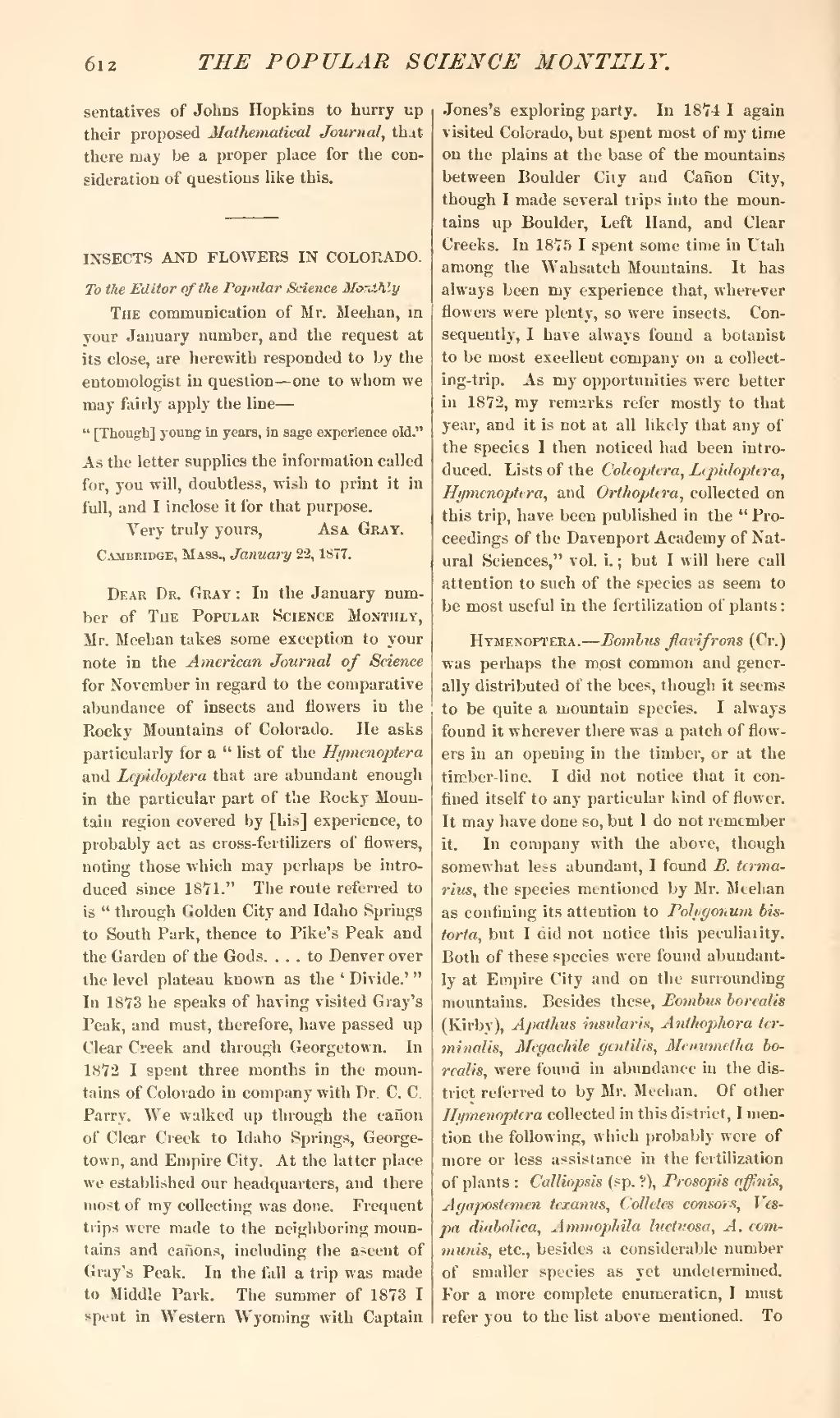sentatives of Johns Hopkins to hurry up their proposed Mathematical Journal, that there may be a proper place for the consideration of questions like this.
INSECTS AND FLOWERS IN COLORADO.
To the Editor of the Popular Science Monthly
The communication of Mr. Meehan, in your January number, and the request at its close, are herewith responded to by the entomologist in question—one to whom we may fairly apply the line—
"[Though] young in years, in sage experience old."
As the letter supplies the information called for, you will, doubtless, wish to print it in full, and I inclose it for that purpose.
| Very truly yours,Asa Gray. |
| Cambridge, Mass., January 22, 1877. |
Dear Dr. Gray: In the January number of The Popular Science Monthly, Mr. Meehan takes some exception to your note in the American Journal of Science for November in regard to the comparative abundance of insects and flowers in the Rocky Mountains of Colorado. He asks particularly for a "list of the Hymenoptera and Lepidoptera that are abundant enough in the particular part of the Rocky Mountain region covered by [his] experience, to probably act as cross-fertilizers of flowers, noting those which may perhaps be introduced since 1871." The route referred to is "through Golden City and Idaho Springs to South Park, thence to Pike's Peak and the Garden of the Gods.... to Denver over the level plateau known as the 'Divide.'" In 1873 he speaks of having visited Gray's Peak, and must, therefore, have passed up Clear Creek and through Georgetown. In 1872 I spent three months in the mountains of Colorado in company with Dr. C. C. Parry. We walked up through the canon of Clear Creek to Idaho Springs, Georgetown, and Empire City. At the latter place we established our headquarters, and there most of my collecting was done. Frequent trips were made to the neighboring mountains and canons, including the ascent of Gray's Peak. In the fall a trip was made to Middle Park. The summer of 1873 I spent in Western Wyoming with Captain Jones's exploring party. In 1874 I again visited Colorado, but spent most of my time on the plains at the base of the mountains between Boulder City and Canon City, though I made several trips into the mountains up Boulder, Left Hand, and Clear Creeks. In 1875 I spent some time in Utah among the Wahsatch Mountains. It has always been my experience that, wherever flowers were plenty, so were insects. Consequently, I have always found a botanist to be most excellent company on a collecting-trip. As my opportunities were better in 1872, my remarks refer mostly to that year, and it is not at all likely that any of the species I then noticed had been introduced. Lists of the Coleoptera, Lepidoptera, Hymenoptera, and Orthoptera, collected on this trip, have been published in the "Proceedings of the Davenport Academy of Natural Sciences," vol. i.; but I will here call attention to such of the species as seem to be most useful in the fertilization of plants:
Hymenoptera.—Bombus flavifrons (Cr.) was perhaps the most common and generally distributed of the bees, though it seems to be quite a mountain species. I always found it wherever there was a patch of flowers in an opening in the timber, or at the timber-line. I did not notice that it confined itself to any particular kind of flower. It may have done so, but I do not remember it. In company with the above, though somewhat less abundant, I found B. termarius, the species mentioned by Mr. Meehan as confining its attention to Polygonum bisiorta, but I did not notice this peculiarity. Both of these species were found abundantly at Empire City and on the surrounding mountains. Besides these, Bombus borealis (Kirby), Apathus insularis, Anthophora terminalis, Megachile gentilis, Menumetha borealis, were found in abundance in the district referred to by Mr. Meehan. Of other Hymenoptera collected in this district, I mention the following, which probably were of more or less assistance in the fertilization of plants: Calliopsis (sp.?), Prosopis affinis, Agapostemen texanus, Colletes consors, Vespa diabolica, Ammophila luctuosa, A. communis, etc., besides a considerable number of smaller species as yet undetermined. For a more complete enumeration, I must refer you to the list above mentioned. To

